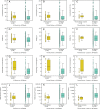Characterizing semen parameters and their association with reactive oxygen species in infertile men
- PMID: 24885775
- PMCID: PMC4047553
- DOI: 10.1186/1477-7827-12-33
Characterizing semen parameters and their association with reactive oxygen species in infertile men
Abstract
Background: A routine semen analysis is a first step in the laboratory evaluation of the infertile male. In addition, other tests such as measurement of reactive oxygen species can provide additional information regarding the etiology of male infertility. The objective of this study was to investigate the association of semen parameters with reactive oxygen species (ROS) in two groups: healthy donors of unproven and proven fertility and infertile men. In addition, we sought to establish an ROS cutoff value in seminal plasma at which a patient may be predicted to be infertile.
Methods: Seminal ejaculates from 318 infertile patients and 56 donors, including those with proven fertility were examined for semen parameters and ROS levels. Correlations were determined between traditional semen parameters and levels of ROS among the study participants. ROS levels were measured using chemiluminescence assay. Receiver operating characteristic curves were obtained to calculate a cutoff value for these tests.
Results: Proven Donors (n = 28) and Proven Donors within the past 2 years (n = 16) showed significantly better semen parameters than All Patients group (n = 318). Significantly lower ROS levels were seen in the two Proven Donor groups compared with All Patients. The cutoff value of ROS in Proven Donors was determined to be 91.9 RLU/s with a specificity of 68.8% and a sensitivity of 93.8%.
Conclusions: Infertile men, irrespective of their clinical diagnoses, have reduced semen parameters and elevated ROS levels compared to proven fertile men who have established a pregnancy recently or in the past. Reactive oxygen species are negatively correlated with traditional semen parameters such as concentration, motility and morphology. Measuring ROS levels in the seminal ejaculates provides clinically-relevant information to clinicians.
Figures



Similar articles
-
Relationship amongst teratozoospermia, seminal oxidative stress and male infertility.Reprod Biol Endocrinol. 2014 May 27;12:45. doi: 10.1186/1477-7827-12-45. Reprod Biol Endocrinol. 2014. PMID: 24884815 Free PMC article.
-
Reference values of reactive oxygen species in seminal ejaculates using chemiluminescence assay.J Assist Reprod Genet. 2015 Dec;32(12):1721-9. doi: 10.1007/s10815-015-0584-1. Epub 2015 Oct 2. J Assist Reprod Genet. 2015. PMID: 26431955 Free PMC article.
-
Physiologic and pathologic levels of reactive oxygen species in neat semen of infertile men.Fertil Steril. 2009 Nov;92(5):1626-31. doi: 10.1016/j.fertnstert.2008.08.109. Epub 2008 Oct 19. Fertil Steril. 2009. PMID: 18937945
-
Should seminal oxidative stress measurement be offered routinely to men presenting for infertility evaluation?Endocr Pract. 2008 May-Jun;14(4):484-91. doi: 10.4158/EP.14.4.484. Endocr Pract. 2008. PMID: 18558605 Review.
-
Withania somnifera improves semen quality by combating oxidative stress and cell death and improving essential metal concentrations.Reprod Biomed Online. 2011 May;22(5):421-7. doi: 10.1016/j.rbmo.2011.01.010. Epub 2011 Mar 8. Reprod Biomed Online. 2011. PMID: 21388887 Review.
Cited by
-
Male subfertility and oxidative stress.Redox Biol. 2021 Oct;46:102071. doi: 10.1016/j.redox.2021.102071. Epub 2021 Jul 18. Redox Biol. 2021. PMID: 34340027 Free PMC article. Review.
-
Resumption of Spermatogenesis and Fertility Post Withdrawal of Hydroxyurea Treatment.Int J Mol Sci. 2023 May 27;24(11):9374. doi: 10.3390/ijms24119374. Int J Mol Sci. 2023. PMID: 37298325 Free PMC article.
-
A Novel Approach to Improving the Reliability of Manual Semen Analysis: A Paradigm Shift in the Workup of Infertile Men.World J Mens Health. 2021 Apr;39(2):172-185. doi: 10.5534/wjmh.190088. Epub 2019 Nov 19. World J Mens Health. 2021. PMID: 31749341 Free PMC article. Review.
-
Proteomic Signatures Reveal Differences in Stress Response, Antioxidant Defense and Proteasomal Activity in Fertile Men with High Seminal ROS Levels.Int J Mol Sci. 2019 Jan 8;20(1):203. doi: 10.3390/ijms20010203. Int J Mol Sci. 2019. PMID: 30626014 Free PMC article.
-
Comparing reactive oxygen species and DNA fragmentation in semen samples of unexplained infertile and healthy fertile men.Ir J Med Sci. 2018 Aug;187(3):657-662. doi: 10.1007/s11845-017-1708-7. Epub 2017 Nov 15. Ir J Med Sci. 2018. PMID: 29143242
References
-
- Jarow JP, Sharlip ID, Belker AM, Lipshultz LI, Sigman M, Thomas AJ, Schlegel PN, Howards SS, Nehra A, Damewood MD, Overstreet JW, Sadovsky R. Best practice policies for male infertility. Male infertility best practice policy committee of the American Urological Association Inc. J Urol. 2002;167:2138–2144. doi: 10.1016/S0022-5347(05)65109-9. - DOI - PubMed
-
- Venkatesh S, Gupta NP, Kumar R, Deecaraman M, Dada R. Correlation of sperm morphology and oxidative stress in infertile men. Iran J Reprod Med. 2009;7:29–34.
-
- Hamada A, Esteves SC, Agarwal A. Unexplained male infertility: potential causes and management. Hum Androl. 2011;1:2–16. doi: 10.1097/01.XHA.0000397686.82729.09. - DOI
MeSH terms
Substances
LinkOut - more resources
Full Text Sources
Other Literature Sources
Medical
Miscellaneous

